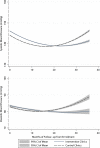Effect of a physician uncertainty reduction intervention on blood pressure in uncontrolled hypertensives--a cluster randomized trial
- PMID: 22033742
- PMCID: PMC3304039
- DOI: 10.1007/s11606-011-1888-1
Effect of a physician uncertainty reduction intervention on blood pressure in uncontrolled hypertensives--a cluster randomized trial
Abstract
Background: Clinical inertia, provider failure to appropriately intensify treatment, is a major contributor to uncontrolled blood pressure (BP). Some clinical inertia may result from physician uncertainty over the patient's usual BP, adherence, or value of continuing efforts to control BP through lifestyle changes.
Objective: To test the hypothesis that providing physicians with uncertainty reduction tools, including 24-h ambulatory BP monitoring, electronic bottle cap monitoring, and lifestyle assessment and counseling, will lead to improved BP control.
Design: Cluster randomized trial with five intervention clinics (IC) and five usual care clinics (UCC).
Setting: Six public and 4 private primary care clinics.
Participants: A total of 665 patients (63 percent African American) with uncontrolled hypertension (BP ≥140 mmHg/90 mmHg or ≥130/80 mmHg if diabetic).
Interventions: An order form for uncertainty reduction tools was placed in the IC participants' charts before each visit and results fed back to the provider.
Outcome measures: Percent with controlled BP at last visit. Secondary outcome was BP changes from baseline.
Results: Median follow-up time was 24 months. IC physicians intensified treatment in 81% of IC patients compared to 67% in UCC (p < 0.001); 35.0% of IC patients and 31.9% of UCC patients achieved control at the last recorded visit (p > 0.05). Multi-level mixed effects longitudinal regression modeling of SBP and DBP indicated a significant, non-linear slope difference favoring IC (p (time × group interaction) = 0.048 for SBP and p = 0.001 for DBP). The model-predicted difference attributable to intervention was -2.8 mmHg for both SBP and DBP by month 24, and -6.5 mmHg for both SBP and DBP by month 36.
Conclusions: The uncertainty reduction intervention did not achieve the pre-specified dichotomous outcome, but led to lower measured BP in IC patients.
Figures



Similar articles
-
Does reducing physician uncertainty improve hypertension control?: rationale and methods.Circ Cardiovasc Qual Outcomes. 2009 May;2(3):257-63. doi: 10.1161/CIRCOUTCOMES.109.849984. Circ Cardiovasc Qual Outcomes. 2009. PMID: 20031846 Free PMC article.
-
Long-term Outcomes of the Effects of Home Blood Pressure Telemonitoring and Pharmacist Management on Blood Pressure Among Adults With Uncontrolled Hypertension: Follow-up of a Cluster Randomized Clinical Trial.JAMA Netw Open. 2018 Sep 7;1(5):e181617. doi: 10.1001/jamanetworkopen.2018.1617. JAMA Netw Open. 2018. PMID: 30646139 Free PMC article. Clinical Trial.
-
Culturally adapted hypertension education (CAHE) to improve blood pressure control and treatment adherence in patients of African origin with uncontrolled hypertension: cluster-randomized trial.PLoS One. 2014 Mar 5;9(3):e90103. doi: 10.1371/journal.pone.0090103. eCollection 2014. PLoS One. 2014. PMID: 24598584 Free PMC article. Clinical Trial.
-
Effects of blood pressure-lowering treatment on cardiovascular outcomes and mortality: 13 - benefits and adverse events in older and younger patients with hypertension: overview, meta-analyses and meta-regression analyses of randomized trials.J Hypertens. 2018 Aug;36(8):1622-1636. doi: 10.1097/HJH.0000000000001787. J Hypertens. 2018. PMID: 29847485 Review.
-
Seasonal blood pressure variation assessed by different measurement methods: systematic review and meta-analysis.J Hypertens. 2020 May;38(5):791-798. doi: 10.1097/HJH.0000000000002355. J Hypertens. 2020. PMID: 32102047
Cited by
-
Vitamin D: an examination of physician and patient management of health and uncertainty.Qual Health Res. 2014 Mar;24(3):375-86. doi: 10.1177/1049732314523681. Epub 2014 Feb 20. Qual Health Res. 2014. PMID: 24558016 Free PMC article.
-
How Behavior Change Strategies are Used to Design Digital Interventions to Improve Medication Adherence and Blood Pressure Among Patients With Hypertension: Systematic Review.J Med Internet Res. 2020 Apr 9;22(4):e17201. doi: 10.2196/17201. J Med Internet Res. 2020. PMID: 32271148 Free PMC article.
-
Clinical inertia in the pharmacological management of hypertension: A systematic review and meta-analysis.Medicine (Baltimore). 2018 Jun;97(25):e11121. doi: 10.1097/MD.0000000000011121. Medicine (Baltimore). 2018. PMID: 29924011 Free PMC article.
-
Providing physicians with feedback on medication adherence for people with chronic diseases taking long-term medication.Cochrane Database Syst Rev. 2018 Jan 10;1(1):CD012042. doi: 10.1002/14651858.CD012042.pub2. Cochrane Database Syst Rev. 2018. PMID: 29320600 Free PMC article.
-
Cognitive biases associated with medical decisions: a systematic review.BMC Med Inform Decis Mak. 2016 Nov 3;16(1):138. doi: 10.1186/s12911-016-0377-1. BMC Med Inform Decis Mak. 2016. PMID: 27809908 Free PMC article.
References
Publication types
MeSH terms
Grants and funding
LinkOut - more resources
Full Text Sources
Medical
Miscellaneous

